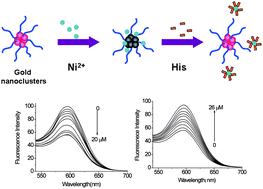Ni2+-modified gold nanoclusters for fluorescence turn-on detection of histidine in biological fluids
Abstract
In this work, Ni2+-modified gold nanoclusters were fabricated for fluorescence turn-on detection of

* Corresponding authors
a
Ministry-of-Education Key Laboratory for the Synthesis and Application of Organic Functional Molecules, College of Chemistry and Chemical Engineering, Hubei University, Wuhan 430062, China
E-mail:
songgw@hubu.edu.cn, songgw2008@yahoo.com.cn
b Engineering Research Center of Nano-Geomaterials of Ministry of Educations, China
In this work, Ni2+-modified gold nanoclusters were fabricated for fluorescence turn-on detection of

 Please wait while we load your content...
Something went wrong. Try again?
Please wait while we load your content...
Something went wrong. Try again?
Y. He, X. Wang, J. Zhu, S. Zhong and G. Song, Analyst, 2012, 137, 4005 DOI: 10.1039/C2AN35712G
To request permission to reproduce material from this article, please go to the Copyright Clearance Center request page.
If you are an author contributing to an RSC publication, you do not need to request permission provided correct acknowledgement is given.
If you are the author of this article, you do not need to request permission to reproduce figures and diagrams provided correct acknowledgement is given. If you want to reproduce the whole article in a third-party publication (excluding your thesis/dissertation for which permission is not required) please go to the Copyright Clearance Center request page.
Read more about how to correctly acknowledge RSC content.
 Fetching data from CrossRef.
Fetching data from CrossRef.
This may take some time to load.
Loading related content
